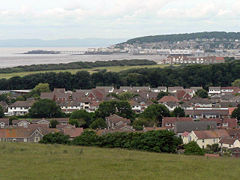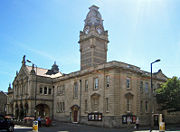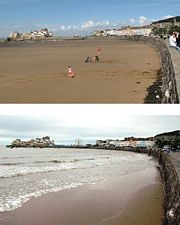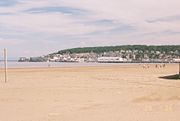Weston-super-Mare
2008/9 Schools Wikipedia Selection. Related subjects: British Cities; Great Britain
| Weston-super-Mare | |
|
Weston-super-Mare shown within Somerset |
|
| Population | 71,758 (2001 Census) |
|---|---|
| OS grid reference | |
| Unitary authority | North Somerset |
| Ceremonial county | Somerset |
| Region | South West |
| Constituent country | England |
| Sovereign state | United Kingdom |
| Post town | WESTON-SUPER-MARE |
| Postcode district | BS22 - BS24 |
| Dialling code | 01934 |
| Police | Avon and Somerset |
| Fire | Avon |
| Ambulance | Great Western |
| European Parliament | South West England |
| UK Parliament | Weston-super-Mare |
| List of places: UK • England • Somerset | |
Coordinates:
Weston-super-Mare is a seaside resort town and civil parish in North Somerset, England. It is located on the Bristol Channel, 18 miles (29 km) south west of Bristol, spanning the coast between the bounding high ground of Worlebury Hill and Bleadon Hill. Its population according to the 2001 census was 71,758. It is twinned with Hildesheim, Germany.
History
Toponymy
Weston comes from the Anglo-Saxon for the west tun or settlement. The descriptive part of its name is unusual because it is in medieval Latin and was first recorded by an unknown medieval church clerk, presumably to distinguish it from other settlements named Weston in the area. It is a popular myth that the description was a later Victorian invention. It means literally "on sea". It is pronounced mair rather than mahrey. Often people will write the town's name as "Weston-Super-Mare"; this however is incorrect, as "super" should always written in lower case.
Early history
Weston's oldest structure is Worlebury camp, on Worlebury Hill, dating from the Iron Age. The medieval church of St John has been rebuilt but its preaching cross survives. The cellars of the adjoining former rectory are said to be 17th century. The Old Thatched Cottage restaurant on the seafront carries the date 1774; it is the surviving portion of a summer cottage built by the Revd. Leeves of Wrington.
19th century
Early in the 19th century, Weston was a small windswept village of about 30 houses, located behind a line of sand dunes fronting the sea, which had been created as an early sea wall after the Bristol Channel floods of 1607. The Pigott family of Brockley, who were the local Lords of the Manor, had a summer residence at Grove House. Weston owes its growth and prosperity to the Victorian era boom in seaside holidays. Construction of the first hotel in the village started in 1808; it was called "Reeves" (now the Royal Hotel). Along with nearby Burnham-on-Sea, Weston benefited from proximity to Bristol, Bath and South Wales. The first attempt at an artificial harbour was made in the late 1820s at the islet of Knightstone and a slipway built from Anchor Head towards Birnbeck Island.
Isambard Kingdom Brunel and his family lived in Weston, at Swiss Villa (eastern corner of Alexandra Parade and Swiss Road), for a number of months whilst he was supervising the construction of the Bristol and Exeter Railway in the area. With the opening of the railway in 1841, thousands of visitors came to the town from Bristol, the Midlands and further afield, on works outings and Bank Holidays. Also, many mining families came across the Bristol Channel from South Wales by paddle steamer. To cater for them, Birnbeck Pier was completed in 1867, offering in its heyday amusement arcades, tea rooms, funfair rides and a photographic studio. However, it now stands in a derelict state and has recently been added to English Heritage's list of endangered buildings, but is still possible for visitors to marvel at the structure from behind the barbed wire. It was designed by Eugenius Birch with ironwork by the Isia Foundry of Newport, Monmouthshire. It is a grade II* listed building.
Large areas of land were released for development from the 1850s onwards. Large detached villas, for the middle classes, were built on the southern slopes of Worlebury Hill. Semi-detached and terraced housing were built on the low 'moorland', behind the sea front in an area known as South Ward. Many of these houses have now been turned into bedsits by their owners. Most of the houses built in the Victorian era are built from stone and feature details made from local Bath Stone, influenced by local architect Hans Price.
In 1885 the first transatlantic telegraph cable of the Commercial Cable Company was brought ashore and the company started a long association with the town, ending in 1962.
A second railway, the Weston, Clevedon and Portishead Railway, opened on 1 December 1897, connecting Weston to Clevedon. The terminus station was at Ashcombe Road. The railway was extended to Portishead on 7 August 1907 but was closed on 18 May 1940.
20th century
Local traders, unhappy that visitors were not coming as far as the centre of the town, began the construction of a new pier closer to the main streets. Opened in 1904, and known as the Grand Pier, it was originally planned to be 1.5 miles (2.4 km) long.
The Grand Pier still stands in truncated form. Amusements and cafes replaced the original music-hall theatre it supported, in a building dating from 1933. Further development occurred after World War I, with the Winter Gardens and Pavilion (1927), the open air pool and an airfield all dating from the inter-war period. Art Deco influences can be seen in much of the town's architecture from this period.
During World War II many evacuees were accommodated in the town. Weston suffered several bombing raids, damaging parts of the town centre, particularly Orchard Street and Boulevard. War industries, such as aircraft and pump manufacture, were dispersed to the town. Many US troops were billeted in Weston. The troops and their equipment quickly vanished, in the run-up to D-Day.
Residential areas include the Oldmixon, Coronation, and Bournville housing estates, which exhibit many examples of early to late twentieth century architecture. Newer housing has since been built towards the east of the town in North Worle and Locking Castle, locations nearer to the M5 motorway.
The town as a whole has expanded in size considerably and at one time in the 1980s was the fastest growing municipality in Europe. Weston-super-Mare has expanded to include the established villages of Milton, Worle, Uphill, Oldmixon, West Wick and Wick St. Lawrence, as well as new areas such as St. Georges and Locking Castle.
21st century
A structure known as Silica was installed at Big Lamp Corner during 2006. It is a piece of public art, an advertising sign, a retail kiosk selling newspapers and hot food, as well as a bus shelter. It has been criticised by some local residents who liken it to a carrot or a space ship, although it is meant to symbolise man's harmony with the sea. This was part of North Somerset Council's ongoing civic pride initiative that has sought to revitalise Weston-super-Mare's public spaces – which had suffered a period of decline.
Other public space improvements have been made throughout the town such as improvements to the street scene in Grove Park Village. There has been some controversy in the town over whether the silica enhanced the town or was a waste of money. However, this debate centred round a misunderstanding of the government funds used to pay for the sculpture. Many local residents did not realise that the money came from central government and had to be used on public art/improvements to the street scene environment. Although a significant part of the funding also came from Weston Town Council and tourism budgets that could have been spent elsewhere. Much of this argument was covered by the Weston & Somerset Mercury. Some residents considered that an attractive water fountain or garden would have been a better investment of this money.
On 28 July 2008, the pavilion at the end of the Grand Pier was completely destroyed by a fire. Eleven fire engines and 80 fire-fighters were unable to contain the blaze which is believed to have started in the north-east tower of the Pavilion.
Governance
Made an urban district in 1894, Weston-super-Mare became a municipal borough in 1937. In 1974, under the Local Government Act 1972, it was merged into the Woodspring district of the County of Avon, and became a Charter Trustees town.
Before 1974, Weston-super-Mare was in the County of Somerset. When Avon was split up in 1996, it became the administrative headquarters of North Somerset, one of the successor authorities. Weston-super-Mare regained a town council in 2000, becoming a civil parish.
The MP for the Weston-super-Mare parliamentary constituency is John Penrose of the Conservative Party, who won the seat in the 2005 General Election.
Geography
The mainly flat landscape of Weston is dominated by Worlebury Hill which borders the entire northern edge of the town, and Bleadon Hill which together with the River Axe, and Brean Down at Uphill form its southern border. In the centre of the town is Ellenborough Park a Site of Special Scientific Interest due to the range of plant species found there.
The beach lies on the western edge of the town. The upper part is sandy but, as the sea retreats a long way with the tide exposing mud flats. The tidal range in this part of the Bristol Channel is great, since the beach and mud flats are on a gentle slope. Consequently it is only at the part of the tide cycle where high tide is in the early morning and late afternoon that the sea comes well up the beach. Many day visitors see little of the sea because of this and also must be confused to see a long pier with little or no water under it. Attempting to reach the sea at these times is inadvisable as the sand gives way to mud which is very deep and has cost several people their lives over the years. Driving on the beach (which is permitted in certain areas) catches people out as they drive too close to the sea and break through the sand to the underlying mud and are then stuck.
The tidal rise and fall in the Severn Estuary and Bristol Channel can be as great as 15 m (49 ft). second only to Bay of Fundy in Eastern Canada. This tidal movement contributes to the deposition of natural mud in bays such as Weston. There has been concern about pollution levels from industrial areas in Wales and at the eastern end of the Bristol Channel, however this tends to be diluted by the Atlantic waters. There are measurable levels of chemical pollutants and little is known about their effects. Of particular concern are the levels of cadmium and to a lesser degree some residual pesticides and hydrocarbons.
Demography
According to the United Kingdom Census 2001, the population of Weston-super-Mare is 71,758. This makes is the largest settlement in North Somerset, which has a total population of 188,564. 20.7% of the town's population are aged 65 or over, compared with the national average of 16%. 98.6% of the population are white, compared with 90.9% nationally. In 1831 the town population was 1,310. In 2001, the town comprised 31,715 households, while in 1829 is comprised just 250.
Transport
The main Weston-super-Mare railway station is close to the town centre less than ten minutes walk from the sea front. Other stations are located at Weston Milton and Worle. Weston-super-Mare station has direct high speed train services to London Paddington including First Great Western's Bristolian express service, which only serves Weston-super-Mare in the London bound direction. Weston-super-Mare main railway station also has direct services to stations such as Bristol, Taunton and Cardiff Central.
Most bus services are provided by First Group, although some services are operated by ACL Travel and 1-Spin Travel, who operate one town service and a night-bus service to Bristol. All services call at stops in the Regent Street and Big Lamp Corner area; a few services to Sand Bay, Wells, Burnham-on-Sea and Bristol International Airport start from or run via the main railway station. Some bus services serve the main High Street.
Weston is close to junction 21 of the M5 motorway. In the 1990s a dual-carriageway relief road was opened from the motorway into the centre of the town. This replaced Locking Road as the designated A370 route and avoided some of the traffic congestion along that narrower urban road.
Industry
Since the 1970s Weston has suffered a large decline in popularity, like virtually all British seaside resorts. The advent of cheap foreign holidays and the break-up of large industries like mining contributed, as working communities became less likely to holiday together. The town had become a centre of industries such as helicopter production, and maintenance at the GKN Westland factory until its closure in 2002. Road transport links were improved with the M5 motorway running close by, and the town now supports several light industries and distribution depots, including Lidl's distribution centre for all its southern based stores, and functions partly as a dormitory town for Bristol. Philip Harris Ltd moved their production unit to the town in the 1970s to join their biological supplies division, which moved from Sheffield in 1965. Some biological supplies work still continues under different owners. Two of the town's largest employers are the local council and Weston College, which has recently begun to offer university degrees as a secondary campus of Bath Spa University.
Culture
The town has a number of arts venues. The Playhouse serves both tourists and the local population. The Winter Gardens on the seafront hosts shows, exhibitions and conferences. The Blakehay Theatre & Community Arts Centre is a small venue housed in a former Baptist church.
Weston-super-Mare has a couple of live music venues of note. Hobbit's on Carlton Street, caters mainly for young up and coming punk and pop acts: whilst the nearby Scally's bar hosts local and national touring rock bands; Juicy Lucy, Alien Stash Tin and Dumpy's Rusty Nuts having performed at the venue in recent years, on the other side of town The Back Bar, The London, and the Imperial hold regular open mic nights which attract a wide array of local musicians, as well as artists from further afield.
The town was the subject of a song Sunny Weston-super-Mare performed by local band, The Wurzels.
The town is also the site of the Upstart art+music Festival , which highlights local artists and musicians.
The historic newspaper in the town is the Weston & Somerset Mercury, which has been serving the population since 1843. The Weston and Worle News is a free weekly newspaper serving the local area.
Sport
Football team Weston-super-Mare A.F.C. play in the Conference South at the purpose-built Woodspring Stadium, which opened in August 2004.
There are two Rugby clubs in the town; Weston-super-Mare RFC, formed in 1875, and Hornets RFC, formed in 1962. They play in South West Division One and South West Division Two (West) respectively.
Somerset County Cricket Club played First Class and One-Day matches for one week a season on a pitch prepared at Clarence Park, near the Sea Front. This began in 1914 and continued until the last “festival” in 1996.
The town is well known amongst motocross enthusiasts for staging the Weston Super Mare beach race every Autumn. Over 900 riders take part in the annual event, with crowds approaching 20,000 spectators. In addition, races are also held for youth riders, sidecarcross riders and quad bike competitors. The most recent winner of the Weston Beach Race was reigning World Motocross Champion Steve Ramon of Belgium.
Tourism
Weston-super-Mare is a popular tourist destination, with attractions such as the long sandy beach, the Helicopter Museum, the Grand Pier (until the fire on 28 July 2008 destroyed the pier pavilion building), the SeaQuarium aquarium and the Weston Miniature Railway, which is situated on the Beach Lawns, as well as a putting green, gift shop and café. Trains on the railway are pulled by steam or petrol locomotives. Also on site is a Drive It Yourself Train. The Paddle Steamer Waverley and MV Balmoral offer day sea trips from Knightstone Island to various destinations along the Bristol Channel and Severn estuary, tickets for which are on sale at the resort's Tourist Information Centre. Museums include the North Somerset Museum.
The T4 On The Beach concert, hosted by Channel 4 youth programme T4, is a recent addition. Many well known bands and singers perform four or less of their hits. However, many of the vocals are mimed as the event is being produced for live TV broadcast.
International HeliDays is usually staged at the beach lawns over a long weekend around the end of July, where helicopters from around the world are displayed, in association with The Helicopter Museum. There is also an annual display by the Red Arrows.
Weston Beach Race is an annual Motorcross Enduro event in October, first held in 1982. In 2005 it attracted 1,400 competitors and around 80,000 spectators. There are a number of races for quad bikes, sidecars and children in addition to the main event.
Weston is also the final event on the November West Country Carnival circuit, when a large number of brightly illuminated floats parade through the streets.
Some of the town's attractions are now past their best.
- Birnbeck Pier, to the north of the town is now derelict, although Manchester-based company Urban Splash who purchased the pier in 2006 will soon announce plans for its restoration.
- Knightstone Island historically housed a theatre, swimming pool and sauna. After years of disrepair and dereliction, the area has been redeveloped by Redrow Homes. During 2006/2007, luxury apartments and commercial outlets have been built on the site. Consideration has been taken due to the listed building status of much of the site. Boat trips from here include the Waverley and Balmoral (see Tourism Section) and trips to Steep Holm Island as well as short trips around Weston Bay.
- The Tropicana located half way along the sea front is now derelict, but once provided an outdoor swimming pool ( Lido) complex. A private developer, Henry Boot, has been selected to take forward the re-development of the Tropicana. Contracts for the new Life Station@Tropicana development were exchanged in March 2007 and will include a 96 bedroom hotel, indoor pool, cinema, bowling alley, restaurants and bars. Re-development of the Tropicana has been beset by delays and controversy, Plans will now be submitted in Autumn 2007 with opening due in Spring 2010.
Before contracts were placed a group of local residents challenged the council over its decision to appoint Henry Boot and asked to put forward their own proposals for the site.
Notable people
Well-known former residents of the town include:
- A. V. Alexander, 1st Earl Alexander of Hillsborough – Minister of Defence in the Attlee government, raised in Weston-super-Mare.
- Jeffrey Archer – author, politician and convicted perjurer
- Ritchie Blackmore – guitarist for Deep Purple and Rainbow
- John Cleese – actor and member of Monty Python
- Roald Dahl – author, journalist
- Jill Dando – murdered broadcaster and journalist, after whom the sixth form centre at Weston College and a garden in Grove Park are named.
- Arthur Stanley Eddington – one of the foremost astrophysicists of the early twentieth century, grew up in the town.
- Rupert Graves – actor
- Bob Hope - comedian and actor, lived here as a child
- Sean Martin – writer and film director
- Mandy Miller – actress
- Con O'Neill – actor
- Dr Sir John Polkinghorne – particle physicist and theologian
- Hans Price – architect
- Paul Radmilovic – Olympic gold medal winner
- Gareth Taylor – Tranmere Rovers footballer (previously with Sheffield United, Burnley and Nottingham Forest)








